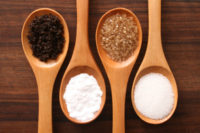Artificial Sweetener Market Trends
Significant changes in consumer behavior having major impact on demand for high-intensity sweeteners

The high-intensity sweetener (HIS) market is a study in contrasts between Western and Eastern consumers—with one going sour, while the other stays sweet. Although new, natural sweeteners like stevia extract are gaining ground, consumption of high-intensity sweeteners as a class is growing at a negligible rate in North America and Europe, due, in part, to the decline in carbonated soft drink consumption in these regions. In contrast, demand for the entire range of high-intensity sweeteners remains strong in Asia, according to new research from IHS Markit (NASDAQ: INFO), the leading global source of critical information and insight.
“Worldwide consumption of high-intensity sweeteners is largely dependent on production of diet carbonated soft drinks, low-calorie food, and sugar substitutes,” said Marifaith Hackett, director of specialty chemical research at IHS Markit and principal author of the IHS Chemical Economics Handbook - High Intensity Sweeteners Report-2017. “Beverages are the largest end-use for high-intensity sweeteners, followed by food, tabletop sweeteners, personal care products (such as toothpaste), and pharmaceuticals.”
”Global consumption of high-intensity sweeteners for all applications totaled more than 159,000 metric tons in 2016,” Hackett said. “Global consumption of these products for sweetener applications totaled more than 146,000 metric tons in 2016, equivalent (in terms of sweetness) to more than 21 million metric tons of table sugar. The value of the market for high-intensity sweeteners in sweetening applications is more than US $2 billion in 2017.”
China is the world’s largest source of high-intensity sweeteners, accounting for 77% of world production in 2017. Indonesia was a distant second, followed by Western Europe, the United States, Japan, and South Korea. The buildup of Chinese HIS capacity in recent years has increased global supplies of these sweeteners, contributing to declining prices and catalyzing the consolidation of the HIS manufacturing industry. Notable recent developments include NutraSweet’s closure of its US aspartame plant in 2014; Ajinomoto’s sale of its French aspartame facility in 2015; and Tate & Lyle’s shutdown of its Singapore sucralose plant in 2016.
Diet soft drinks, low-calorie yogurt, and sugar-free jam taste as sweet as their “regular” counter-parts because they contain high-intensity sweeteners, the IHS Markit report noted. Aspartame, sucralose, acesulfame K, saccharin and other high-intensity sweeteners have zero calories, but they are many times sweeter than table sugar. In addition, high-intensity sweeteners are non-cariogenic – they do not cause cavities.
“Growing concerns regarding obesity and the connection between diet and major diseases such as diabetes and heart disease have caused consumers to reexamine their diets and lifestyles and seek healthier alternatives, including low- or no-calorie versions of food and beverages,” Hackett said. “National and local governments see the diabetes epidemic as a public health issue and many are considering taxes on soft drinks as a means of fighting obesity. High-intensity sweeteners enable food producers to deliver reduced-calorie products that taste good. Sugar-free gum, for example, outsells regular gum.”
In North America and Europe, consumption of soft drinks – a major end-use for high-intensity sweeteners – is declining significantly. As a result, demand for some artificial sweeteners is flat or decreasing in these regions. “We are seeing a significant shift in consumer behavior and preferences in Western Europe and North America,” Hackett said. “Health-conscious consumers are drinking fewer sodas. In addition, they are seeking out beverages and foods made with natural ingredients, including sweeteners such as stevia extract. The challenge for food producers is to find sweeteners that meet consumer expectations but also taste good and meet cost and performance parameters. When it comes to taste, refined sugar remains the ‘gold standard.’”
Most high-intensity sweeteners have come under fire from activist organizations and bloggers, but aspartame seems to have ‘borne the brunt’ of attacks, at least in the United States. Although the US Food and Drug Administration (FDA) continues to regard aspartame as safe, several food and beverage producers have voluntarily removed aspartame from their products in response to consumer requests. For example, PepsiCo removed aspartame from Diet Pepsi in 2015, replacing it with sucralose, another HIS. Ironically, customer demand prompted PepsiCo to bring back the aspartame-sweetened version of the diet soda in 2016.
According to the IHS Markit report, the growing concern over health and nutrition is driving increased interest in natural sweeteners. Stevia extract, which is derived from the leaves of the stevia plant and grows naturally in South America, has been the primary beneficiary of consumer interest, followed by monk fruit extract. Monk fruit, a green melon-like fruit from China, is a relative of watermelons and pumpkins. Both stevia and monk fruit have been used as sweeteners in their native countries for hundreds of years.
“Last year, global demand for stevia extract was slightly more than 3 thousand metric tons, which is quite small when compared to demand for some of the more established sweeteners such as saccharin or cyclamate,” Hackett said. “Demand is growing strongly in both developed and developing markets, and by 2021, we at IHS Markit expect demand for stevia extract to reach 4 thousand to 5 thousand metric tons annually.”
Looking for a reprint of this article?
From high-res PDFs to custom plaques, order your copy today!





